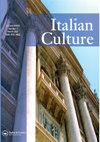On “Savage Thought”: Gabriele D’Annunzio, Guido Boggiani, and Italy’s Transatlantic Mediterranean Empire
IF 0.3
0 HUMANITIES, MULTIDISCIPLINARY
引用次数: 0
Abstract
AbstractCritics have long debated the degree to which Gabriele D’Annunzio should be viewed as a fascist and an imperialist, a virtual daguerreotype for Mussolini. But D’Annunzio’s evolving investment in an Italian empire-state suggests that we should complicate our understanding of his links to fascism. This essay traces correspondences between “savage thought,” coming out of ethnographic anthropology from Latin America, and D’Annunzio’s “recovery” of Hellenistic Greece at the turn of the century. It examines three important moments in D’Annunzio’s literary career: his tour-de-force novel of scandal, Il piacere (Pleasure, 1889), his famous 1895 yachting tour of the Greek islands, and then the writing of Maia (1903), the first book of his epic poem in praise of empire, Le laudi (1903-1917). By reexaming these texts through a transnational lens, the essay demonstrates the global scope of the author's avant-garde literary project and considers its impact on colonial contexts across the Atlantic.Keywords: colonialismindigeneityfascismavant-gardeGreeceParaguay Notes1 As Renato Poggioli has described in his seminal text about radical twentieth-century art: “The avant-gardes turn their attention almost exclusively to negroid sculpture and the art of savages, prehistoric graffiti and pre-Columbian Indian art; they turn, in short, toward cultures remote in space and time, almost to pre-history itself. … the avant-garde can evaluate archaic traditions better than official art and conservative criticism can, if only by way of polemical reaction to the erroneous interpretations and evaluations of the academy” (Poggioli Citation1968: 55).2 More than one critic has noted, Sperelli was a barely disguised cipher for the author (Hughes-Hallett, Citation2013, 113–4).3 Francesco Paolo Michetti, for example, described a Nietzschean spiritual transformation, after D’Annunzio returned from Greece, saying that he sketched the first portrait of the artist as “superman:” “Ora, il Gabriele D’Annunzio rappresentato da quel pastello è un uomo tutto nuovo che sembra non avere più niente in comune con i ritratti precedenti. In questi ultimi, l’insieme della fisionomia è dolce, lo sguardo un po’ abbassato, i baffi modesti, con un sorriso vagamente malinconico. Al contrario, nel pastello, i tratti sono duri, i baffi si sollevano come lunghi uncini, la barbetta a punta minaccia, gli occhi sono aggressivi, le sopracciglia un po’ aggrottate. Quel pastello è certamente il primo ritratto di D’Annunzio ‘superuomo’” (Cited in Alatri, Citation1983, 164). An engraving of D’Annunzio aboard the yacht eventually adorned an early edition of his memoirs (Vittore Nardelli, Citation1931).4 As Martins observes, both Boggiani and then later Levi-Strauss were also under the influence of ideas that emanated from archaeology and were searching for the traces of previous or pre-modern civilizations in their ethnographic studies of Latin American indigenous (Marins 2017). Boggiani’s foundational study of the Caduveo indigenous, Viaggi D'un Artista Nell' America Meriodionale. I Caduvei (mbayá O Guaycurú), was published in the same year he toured Greece (Guido Boggiani and Colin, Citation1895).5 D’Annunzio’s record of the voyage of the Fantasy became available posthumously with a critical edition of his journals or Taccuini writing published by Mondadori in 1965. Mario Cimini has provided the most recent edition of these diaries and has further annotated the notes and diaries of the other travelers (Cimini Citation2010).6 The legacy and influence of Byron on Italian nationalism—and the conversion of liberal to fascist values of nationalism—has been widely studied. See Arnold Anthony Schmidt Citation2010, 179-816, and David Aberbach Citation2008, 478-497. Bu it is also worth observing that Mantegazza also saw ancient Greek cultures as sexually liberated. He moreover authored the first modern work of sexology, The Physiology of Love in 1873 (Mantegazza and Pireddu Citation2008), which D’Annunzio surely would have read.7 “Vale bene tutta la Grecia; per me vale anche di più perchè rappresenta l’Italia intera!”8 As he wrote to Hérelle, Laudi “una parte importante del poema è consacrata al viaggio in Grecia in cui mi foste compagno.” “Carteggio 562,” undated letter, approximately April 18, 1903.9 D’Annunzio completed the Laudi over the course of sixteen years, beginning in 1896 after his return from Greece, and then completing the last cycles of the poem in 1911 during the Italian war for a colony in Libya. On the relationship between epic poetry and empire, see Quint, Citation1993.Additional informationNotes on contributorsValerie McguireValerie McGuire is an Associate Professor of Instruction at the University of Texas at Austin. Her book Italy’s Sea: Empire and Nation in the Mediterranean, 1895-1945 (Liverpool University Press, 2020) retraces the history of discourses of Mediterranean-ness in Italian colonial rule of the Aegean. She is also co-editor of Italian Fascism in Rhodes and the Dodecanese, 1923-44 (Routledge, 2024) and author of other essays in the Journal of Romance Studies, California Italian Studies, and The Journal of Greek Social and Contemporary History, as well as book chapters on transnational approaches to Italian Studies.Correspondence to Valerie Mcguire. Email: vmcguire@utexas.edu关于“野蛮思想”:加布里埃尔·达南齐奥、吉多·博吉亚尼和意大利的跨大西洋地中海帝国
长期以来,批评家们一直在争论加布里埃尔·达南齐奥应该在多大程度上被视为法西斯主义者和帝国主义者,是墨索里尼的达盖尔版。但是,丹农齐奥对意大利帝国的不断发展的投资表明,我们应该使我们对他与法西斯主义的联系的理解复杂化。这篇文章追溯了来自拉丁美洲的人种人类学的“野蛮思想”与达南齐奥在世纪之交对希腊化希腊的“恢复”之间的对应关系。本书考察了达南齐奥文学生涯中的三个重要时刻:他的著名丑闻小说《Il piacere》(《Pleasure》,1889),他1895年著名的希腊群岛游艇之旅,以及他的第一部赞美帝国的史诗《Le laudi》(1903-1917)的写作。通过跨国视角重新审视这些文本,本文展示了作者先锋文学项目的全球范围,并考虑了其对大西洋彼岸殖民背景的影响。正如雷纳托·波焦利(Renato Poggioli)在他关于20世纪激进艺术的开创性著作中所描述的那样:“先锋派几乎完全把注意力转向黑人雕塑和野蛮人的艺术、史前涂鸦和前哥伦布时期的印第安人艺术;简而言之,他们转向了遥远的空间和时间上的文化,几乎是史前本身。……先锋派可以比官方艺术和保守的批评更好地评价古老的传统,如果只是通过对学院的错误解释和评价的辩论反应”(Poggioli citation, 1968: 55)不止一位评论家指出,斯佩雷利对作者来说是一个几乎不加掩饰的密码(Hughes-Hallett, Citation2013, 113-4)例如,弗朗西斯科·保罗·米凯蒂(Francesco Paolo Michetti)在达南齐奥从希腊回来后,描述了尼采式的精神转变,说他把达南齐奥的第一幅肖像描绘成“超人”:“哦,加布里埃尔·达南齐奥(Gabriele D’annunzio)代表了da quel pastello è unuomo tutto nuovo che sembra non avere più niente in comune con i ritratti precedi。”在最后的问题上,我的投资della fisionomia è dolce, lo sguardo un ' abbassato, i baffi modesi, con sorriso vagamente malinconico。相反的是,我喜欢肉酱,我喜欢烤肉,我喜欢烤肉,我喜欢烤肉,我喜欢烤肉,我喜欢烤肉,我喜欢烤肉,我喜欢烤肉,我喜欢烤肉,我喜欢烤肉,我喜欢烤肉。Quel pastello è certamente il primo ritratto di D ' annunzio ' superuomo '”(引自Alatri, Citation1983, 164)。D 'Annunzio在游艇上的雕刻最终装饰了他回忆录的早期版本(Vittore Nardelli, Citation1931)正如马丁斯所观察到的,博格贾尼和后来的列维-斯特劳斯都受到了考古学思想的影响,他们在对拉丁美洲土著的民族志研究中寻找以前或前现代文明的痕迹(Marins 2017)。Boggiani对Caduveo土著人的基础研究,Viaggi D'un Artista Nell' America Meriodionale。I Caduvei (mbay<e:1> O Guaycurú),出版于他游历希腊的同一年(Guido Boggiani and Colin, Citation1895)达南奇奥关于幻想号航行的记录在他死后被蒙达多利于1965年出版了他的日记或塔库尼作品的评论版。Mario Cimini提供了这些日记的最新版本,并进一步注释了其他旅行者的笔记和日记(Cimini Citation2010)拜伦对意大利民族主义的遗产和影响——以及民族主义自由主义价值观向法西斯主义价值观的转变——已经得到了广泛的研究。参见Arnold Anthony Schmidt Citation2010, 179-816和David Aberbach Citation2008, 478-497。但同样值得注意的是,曼特加扎也认为古希腊文化是性解放的。此外,他还于1873年撰写了第一部现代性学著作《爱的生理学》(Mantegazza and Pireddu Citation2008),达南齐奥肯定读过这本书“Vale bene tutta la Grecia;per me vale anche di più perchè rappresenta l 'Italia intera!8他写信给海姆斯莱说:“我的诗很重要,我的诗很重要,我的诗很重要,我的诗很重要。”“Carteggio 562”,未注明日期的信件,大约写于1909年4月18日。D 'Annunzio花了16年的时间完成了这首诗,从1896年他从希腊回来后开始,然后在1911年意大利在利比亚的殖民地战争期间完成了这首诗的最后几个周期。关于史诗与帝国的关系,见昆特,《引文》1993。附加信息撰稿人备注瓦莱丽·麦奎尔瓦莱丽·麦奎尔是德克萨斯大学奥斯汀分校的教学副教授。她的书意大利的海:帝国和国家在地中海,1895年至1945年(利物浦大学出版社,2020年)追溯地中海的历史,在爱琴海的意大利殖民统治的话语。 她也是《1923年至1944年在罗德岛和多德卡尼斯岛的意大利法西斯主义》(劳特利奇出版社,2024年出版)的共同编辑,并在《浪漫研究杂志》、《加州意大利研究》和《希腊社会与当代历史杂志》上发表了其他文章,以及关于意大利研究跨国方法的书籍章节。与瓦莱丽·麦奎尔的通信。电子邮件:vmcguire@utexas.edu
本文章由计算机程序翻译,如有差异,请以英文原文为准。
求助全文
约1分钟内获得全文
求助全文

 求助内容:
求助内容: 应助结果提醒方式:
应助结果提醒方式:


